Hello Friends,
It’s been some time since our last dispatch. We’ll talk about it in a bit, first— the news that is prompting our writing to you this morning.
You may’ve already seen it: reports online that Kinney County Sheriff Brad Coe may have unilaterally decided to begin deporting illegal aliens back to Mexico on his own.

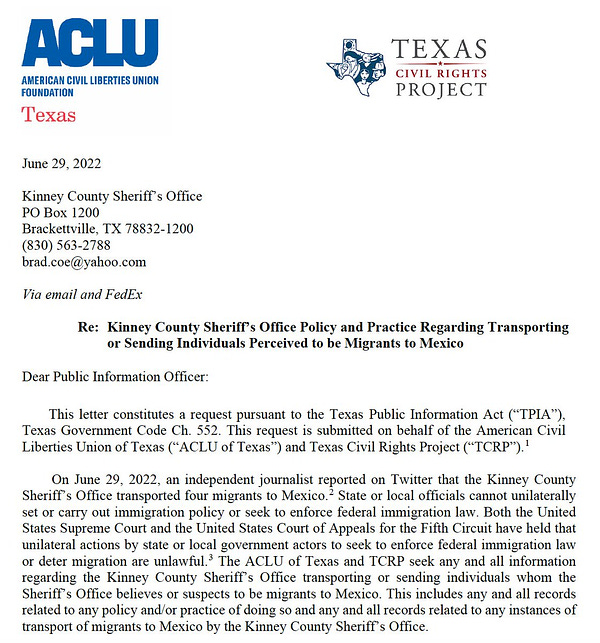

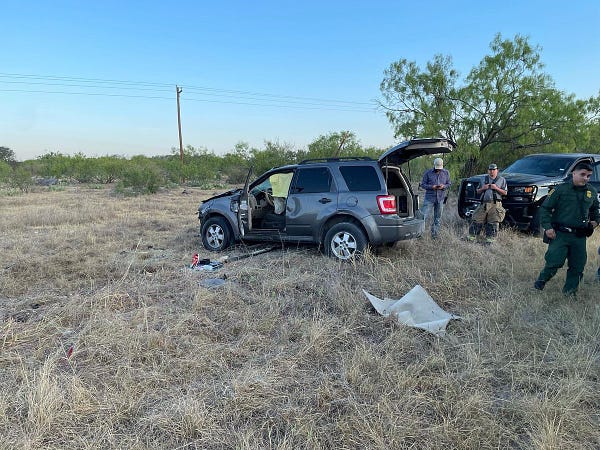

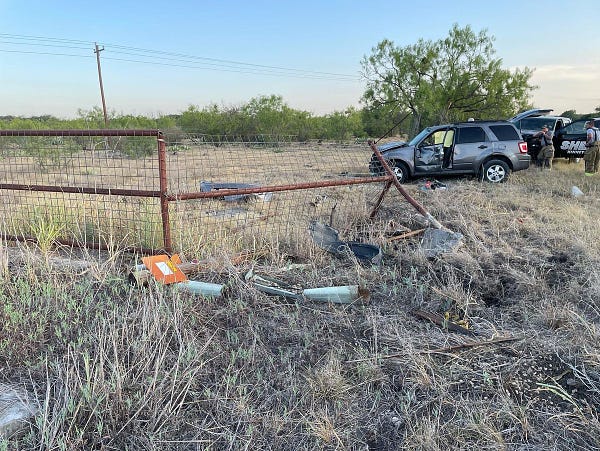

In this case, the truth is at once, both simpler and also more nuanced than is being presented here.
Even as many allege a gross violation of immigration law by the Sheriff and his deputies, what’s really being exposed is a broad gray area between where the law stops and Border Patrol and DHS policies begin.
We are witnessing the results of an ongoing breakdown in the US Border Patrol and an expression of how out-of-control and overrun this section of the U.S. - Mexico Border truly is.
What many are missing in their rush to barbecue the Sheriff, is the fact that Border Patrol refused to take custody of these illegal aliens after their car crash— insisting that they had to see an M.D. first, and be cleared by that Doctor, before Border Patrol would take custody. It must be said that all four individuals were refusing medical attention.
Sounds simple enough, but it isn’t. On this given day, the Sheriff had two deputies available to patrol and police the county. Sending one or both to babysit 4 illegal aliens that were refusing medical anyway, to sit in an emergency room for 4-to-8 hours waiting to see a physician is just out of the question for a resource strapped county.
What is one to do?
In this case, the Sheriff paired the 4 up with a couple deputies who live in Eagle Pass and commute to Kinney County daily. The deputies were ending their shift and it was a simple enough matter for them to casually deliver the illegal aliens to the Port of Entry there.
Our understanding is that there was some initial confusion about matters on the part of the personnel on duty at the Bridge in Eagle Pass, but that like some kind of an internet meme, once a deputy explained what was happening “everybody clapped.”
Who knows. Maybe they did clap. Theoretically the aliens would’ve been able to turn around and disappear into Eagle Pass, but odds are good they would’ve had an easier time reconnecting with their contacts and resupplying in Piedras Negras.
Truth is— this development is actually one that the illegal aliens were probably most pleased with. Instead of spending the night in a Border Patrol holding facility, they were free to begin planning their return.
Odds are quite high, that by the time anyone reads this, they’ve already crossed the river again and are making their way to a rendezvous point for another pickup by another smuggler.
Realize, these were not casual asylum seekers. Casual asylum seekers are turning themselves in to Border Patrol by the hundreds— by the thousands—daily in Eagle Pass, and Del Rio, part of a well-oiled machine that is processing and passing South and Central Americans into the interior of the United States in numbers that are by all accounts well into the millions by now.
Instead, these were individuals actively trying to avoid Border Patrol and U.S. Customs. Why? Well, many possible reasons. The most likely, is that they are Mexican citizens looking for under-the-table work and know that they would’ve been deported by Border Patrol. They might’ve been some other nationality— don’t actually know— but it doesn’t matter in the end. There are significant numbers of people from certain nations and places that are even now, unable to enter the U.S. and qualify for asylum. They are piling up in Mexican border towns— thousands and thousands of Guatemalans, Haitians, and others, who want to cross but face the prospect of being turned away. Their solution is to cross anyway, and pay smugglers to get them to San Antonio. Or Houston. Oklahoma City. Tampa. Wherever. We are looking at a free-for-all, in general. Doesn’t really matter in the end. Four people walk across the bridge into Mexico— another 400 are crossing somewhere else less than 2 miles north or south of there.
Above is a news release we issued on the Sheriff’s behalf Tuesday Morning(Jun 28), before all of this began. These numbers are bananas. 4500 Illegal aliens cutting through ranches, in a place where the county seat supports about 1700 people. This is bonkers. It’s like the county is some kind of a reverse-clown-car of illegal immigration.
Since the publication of that news release, we’re told two more dead illegal aliens have been found on area ranches. And one local brush cutter and tracker tells us he saw signs of a fourth individual that was in distress but lost his trail and was unable to find him.
Apparently, we are told, one can follow a straightforward set of tracks, and then start to see heat exhaustion set in. A steady pace becomes erratic. The walker veers from side to side along the trail. Then, they start walking in circles. They leave the trail. Maybe they come back to it. Maybe they just head off into the brush, behaving irrationally. The erratic behavior makes it much harder to track them— logic stops applying— one becomes less able to predict their behavior and sooner or later, one either finds them, collapsed in a heap, or just loses the trail. In this case the trail was lost.
Imagine what that must be like. Realizing, as one’s own mouth becomes drier and drier— as the anvil of the sun pounds down on your neck and shoulders— you are reading the tale of what is probably the end of another’s life. A secret, coded message, that right now, only you may read— spelled out in the prints of their shoes and the way they are meandering more and more back and forth across the trail you are following. It must be a sickening feeling, even as one ponders the perhaps selfish relief of air conditioning and refrigerated water that awaits.
Let’s get back onto the subject of these illegal aliens that were returned to the bridge. If you didn’t know, there’s quite a big difference between a deputy taking people across the bridge into Mexico and releasing them, and simply dropping them off at the Port of Entry.
In the former case— the Deputy would almost certainly be subject to possible arrest by Mexican Authorities. Contrary to what you might think, U.S. lawmen are not casually tolerated— Mexico takes their border security very seriously. Like their gun control.
Even so, this should not detract from what the Sheriff has done here. This incident comes at a time when yours truly has started to believe that by and large, most Americans simply do not care about the Southern border crisis. Lets be honest— to most folks, it is simply just noise. An annoying distraction as they try to focus on whatever else is in front of them. It is the classic newsman’s dilemma, writ large. How do you get someone to pay attention to what you’re saying in between the razor blade commercials? Most of the time you really can’t. Gillette— the best a man can get.
It takes something visceral, and in-your-face to cut through the noise.
So, do not be shocked if the federal government makes no comment on this matter. If they and the Governor and State of Texas seem to just ignore it. Sooner it all goes away, the sooner they can get back to business, which seems to be inviting some Central and South Americans in, but not others.
Weird.
Before we call it a newsletter, we want to give a shoutout to the only other routinely published substack that covers border issues, the Border Chronicle. They have a very different political outlook than we— but they’ve produced a podcast, featuring Kinney County resident Windy Goodloe. Ms. Goodloe, like ourselves, is a product of Kinney County public schools, and also like ourselves, she really ought to write more.
She comes to their attention, as one of the custodians of the history of the Black Seminoles of Texas. Many conflate them with the larger body of Buffalo Soldiers employed by the US Army during the frontier wars, but it’s an injustice and slight to the Seminoles and their amazing story to do so. Honestly— just the story of the life of John Horse, the patriarch that led the Black Seminoles from Oklahoma to Mexico, dodging U.S. Slavetakers and the Texas Rangers the entire way, would make a heck of a book or film.
As a child, John Horse apparently caught the eye of one U.S. Army Officer for selling his cook the same turtle over and over again. The turtle may have been an escape artist. But it’s believed that Horse was actually creeping into the Cook’s yard and filching the amphibian for resale. Major Turtle-Buyer apparently really wanted some turtle soup.
Long story short, the Black Seminoles lived in Mexico for a time, acting as a border patrol for the Mexican Government, keeping watch over the Rio Grande, before eventually being convinced by the US Army to return to the U.S. and take up residence at Fort Clark in what is now Kinney County. In a way, you might say they were America’s first Border Patrol, after learning their trade in Mexico, and were put to work by the U.S. Cavalry as an elite force of trackers, scouts, and indian fighters, who also kept a close watch for any incursions by bandits based in Mexico at the time. This small body of men saw service all over the frontier, valued for their strength, physical courage, and valor. 4 of them were awarded the U.S. Congressional Medal of Honor, and are buried in Kinney County. By way of comparison, in the entirety of the city of San Antonio and its broad U.S. Military history, there is only one holder of the U.S. Medal of Honor.
Why were the Seminoles being pursued in to Mexico in the first place? Again, long story. Put short, it amounts to corrupt Indian Affairs officials conspiring with sanctioned slavers and Creek Indians who understood how much money there might be made by enslaving the Black Seminole population, who were said to be skilled farmers and trained and fierce fighters.
It resulted in a sort of Exodus, that saw the Black Seminoles run for their freedom, steps ahead of those coming after them with the full weight and authority of the U.S. Government at the time. They didn’t have Moses to part the Red Sea, but they did have John Horse and others, getting them to freedom.
Make some noise in the comments or by email if you want to know more, and maybe we’ll do a whole newsletter on the subject. As fine a job as the podcast does in delivering the broad strokes, there’s much more tale to be told.
Anyway— give the podcast a listen— highly recommend, Ms. Goodloe does a fine job representing the Black Seminoles, and Kinney County at large, giving an evenhanded perspective on how in her opinion, the Border crisis is a mixed bag, with what seems to be fearmongering on one hand, but also acknowledging how the present harbors a dangerous and shameful condition, fraught with human costs and miseries. It’s a bit of a tightrope, but she does a pretty good job of walking it. It’s 30 minutes long. You’ve spent 30-minutes staring out the window at nothing at some point, one wagers. This will be a much better time spend.
While we’re talking about the Border Chronicle, they posted a recent note outlining the economic realities of independent journalism these days. It doesn’t really pay well. And it kind of helps inform our feelings about how the vast majority of people out there don’t really care about the Border crisis.
Our understanding is that the Border Chronicle is one of a handful of publications started up with funding from Substack itself. Kind of like a fellowship grant. Or an author’s advance. In exchange for the upfront money, the writers there committed to making a go of it, and have been hoping to earn enough paid subscribers to support continued publication once a year’s time has passed.
Say what you will about their politics, the quality of their reporting is high. They’re professional and published authors with a long-standing familiarity with much of the Rio Grande Valley and other border areas— and recent events have compelled them to visit the dusty reaches of the Del Rio sector as well.
All that said, they’ve apparently managed to raise about $19-thousand according to their fundraising note. That’s not a bad sum. But it’s not nearly enough for someone looking to quit their day job, let alone two people who are also employing a couple other support staff.
One would think there would have to be more people out there on the left-of-center, looking for unique voices and unexpected angles of border coverage and willing to pay for it. But apparently not. Which returns us to the conclusion that the vast majority of folks out there are still asleep on the border. They’d care— if they were awake— but shhh— still sleeping.
As for the Border Chronicle, we hope they find a way to stay in the game. The border needs all the help and attention it can get, whatever direction it’s coming from.
That’ll do it for now.
We hope that as rushed and ragged as this particular installment feels to us right now, our readers will remain with us as we resume a more frequent publishing schedule. There are reasons we’ve been silent— some related to sloth, others not. It’s tricky, facing a self-imposed need to be circumspect as the county prepares for an upcoming lawsuit in federal court over Operation Lone Star and its participation. While we are not involved in those preparations, there’s an argument to be made that it’s easier to avoid putting one’s foot wrong if one is saying nothing at all.
As always, we should mention that any errors or other misdeeds committed in this newsletter are ours alone and should not reflect on the Kinney County Sheriff’s Office which employs us. Any opinions expressed here are likewise, ours alone, and should not be taken as official statements of policy and belief on behalf of County officials. This newsletter’s genesis predates our employment with the county, and we attempt to maintain it out of a sense of obligation to our readers. And, also, because we enjoy it.
We post this in the spirit of full disclosure and also to remain in keeping with the County’s policies regarding employees and social media.
Have a great day, we’ll see you again soon— hopefully sometime around the 4th of July.



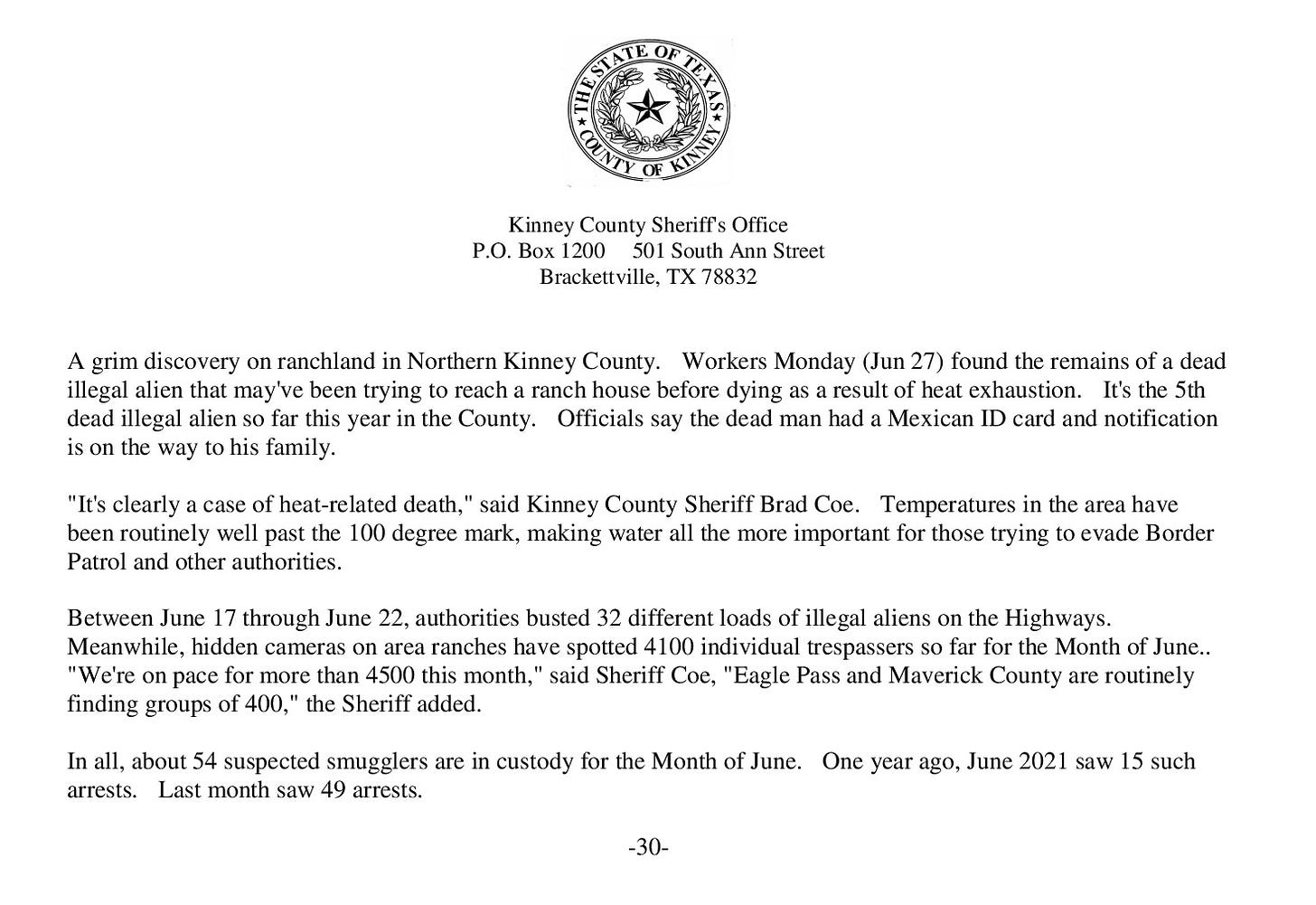
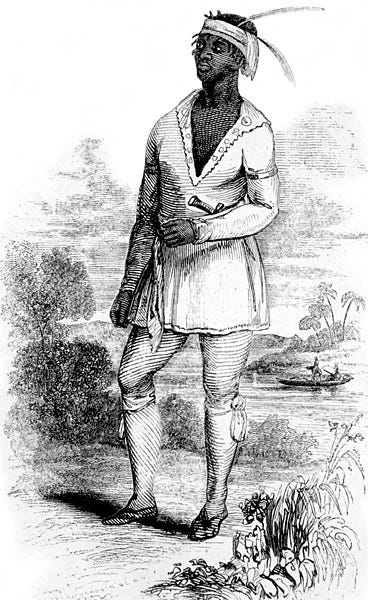
Another great article, Matt. More about the Seminoles would be nice. Keep up the good work.
A very interesting dispatch. The seminoles as border patrol is a concept that doesn’t immediately occur. I feel the story of John Horse deserves an audience. Windus and company deserve the attention as well. The stories of the Indian wars and Texas independence are worth remembering. The sacrifices made, and the blood spilled on both sides are what are being squandered in the present day.